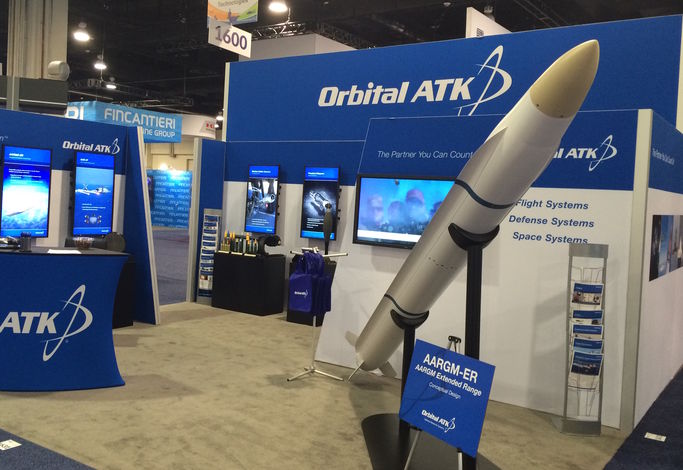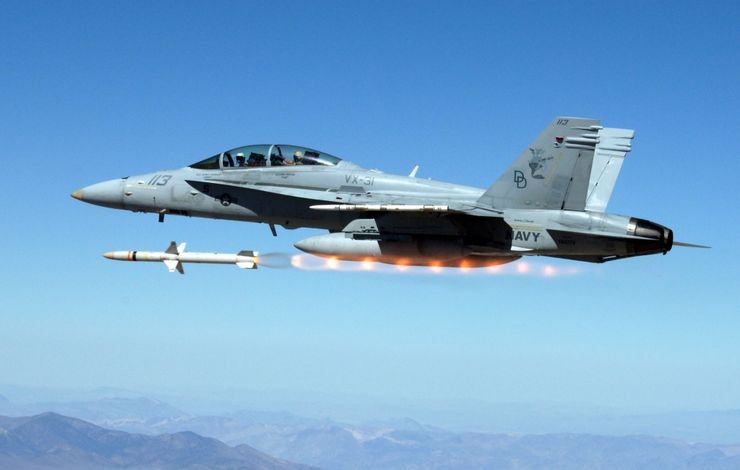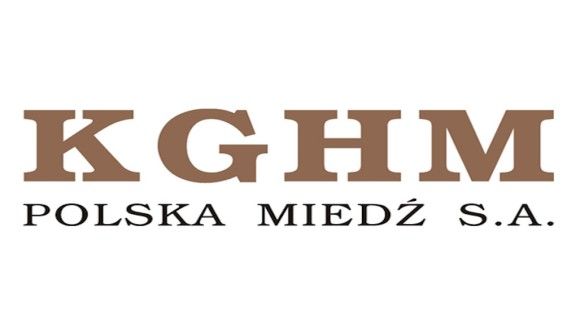AARGM-ER - Anti-Radiation Missile for the 5th Generation Fighter Aircraft
US Navy is currently involved in development works concerning an Extended Range (ER) upgrade to their current Advanced Anti Radiation Guided Missile , the AARGM-ER. As a result of the undertaken works, a missile of much greater range and offering significantly expanded abilities for Destruction of Enemy Air Defenses (DEAD) missions would be created. Moreover, the weapon’s design assumptions are that it shall be carried by the F-35 in its internal weapons bay.
The initial efforts on the AARGM-ER programme began back in the year 2016. According to the US Department of Defense FY2018 Budget Request, the goal of the programme is to expand the abilities provided by the AARGM weapon utilized now. The new missile is to have extended range, higher effectiveness against newly emerging, advanced threats, and a greater battlefield survivability.
In an interview with Defence24.pl, AARGM programme Director at the Joint NAVAIR Command, fusing the naval aviation of US Navy and USMC, Capt. Al Mousseau suggests the following: “AARGM-ER will incorporate hardware and software modifications to improve AGM-88E AARGM capabilities and meet the approved requirements. The development timeline supports an Initial Operational Capability in FY2023”. In practical terms, the above means that the new AARGM variant could be offered to export users in the middle of the next decade.
Orbital ATK is the US Navy’s prime contractor for the AARGM programme. AARGM is a cooperative development program carried out by the US Navy and the Italian Air Force. As we were informed by Capt. Al Mousseau, Orbital ATK was also awarded a sole-source contract to analyse the AARGM front end for integration on the AARGM-ER. The acquisition strategy for AARGM-ER Engineering and Manufacturing Development will be officially approved at Milestone B, planned to occur in FY2018.
AARGM-ER missile is to become one of the elements of the US Navy arsenal, developed within the framework of an integrated system which would facilitate operations in anti-access/area-denial (A2/AD) scenarios. In practical terms, A2/AD refers to enemy environments protected by integrated air/missile defence systems, or ground-to-ground and ground-to-surface missile launchers, deployed with a purpose to make it more difficult for the reinforcing forces to access the area controlled by the enemy. Kaliningrad Oblast is defined as one of the most important A2/AD zones, where S-400 and S-300 SAMs have been stationed since some time now. The very same region has seen periodic or fixed deployments of Bastion anti-ship and Iskander ballistic missiles. Hence, AARGM-ER is one of the elements of a system which could cope with breaking through a similar, layered defence arrangement.
Navy Integrated Fire Control systems, as defined by the US Navy, are to make it possible to act against targets staying beyond the range of radars installed onboard the carrier platforms (aircraft, vessels), also allowing the user to act against cooperating assets with the use of the weapon solutions mentioned above. Ashton Carter who was the US Secretary of Defense at the time, back in February 2016, listed the AARGM-ER missile as one of the elements which would contribute to bolstering of the US Navy strike abilities in the conditions in which enemy uses numerous countermeasures, alongside the LRASM anti-ship missiles and modified Tomahawk missiles, with the latter ones also remaining capable of acting against the enemy ships, not only the ground, stationary targets.

The FY2018 Presidents Budget clearly supports this capability by providing funding and direction for the AARGM-ER programme. This shows commitment by the current administration as well. Initially it has been assumed that the AARGM ER would fuse the warhead and target detection and tracking system of the current AARGM weapon, with a new propulsion system, allowing the missile to attain a much greater range. The overall AARGM design is anticipated to also undergo major changes, to provide the missile with a greater speed, which would translate into expanded operational envelope, in conditions in which the enemy applies relevant countermeasures. In practical terms, the above probably means that the designers would focus on developing the missile taking the stealth design philosophy into account.
Capt. Mousseau noted that “An Industry Day was held for the AARGM-ER propulsion system to solicit industry input and inform planning for propulsion system development.”
Orbital ATK has already prepared a design concept for AARGM-ER. The Orbital ATK concept assumes, in line with the plans made by the Navy, that currently existing sensor, seeker and warhead technologies would be incorporated within the new outer mold line (OML) of their AARGM ER design concept.
According to the concept adopted, AARGM-ER would be fitted with newly designed flight control surfaces in the tail section, making it possible to reduce the in-flight drag. The current AARGM control surfaces located in the central part of the missile are to be eliminated entirely. The Orbital ATK AARGM ER design concept add strakes oriented longitudinally diminishing the drag even further while providing lift. Orbital ATK’s design concept includes a thermos barrier / heat shield required due to the very high speeds over the flight of the missile. One may postulate that the aforesaid changes could also contribute to stealth abilities of the missile (also by eliminating the central stabilizer surfaces).
As a result of the above, the Orbital ATK AARGM-ER design concept is to be characterized by doubled range, when compared to its predecessor. According to the NAVAIR Command, the existing AARGM missile is said to have a range of more than 60 nautical miles, however, the command did not confirm the information related to the exact extension of the missile range, within the programme planned.

Thus, a statement may be made that the AARGM programme, as such, enters a new phase. It is being implemented in a gradual manner. The current missile has been created through introduction of a new guidance system, integrating the digital passive radar system, active millimetre radar, and a combined INS/GPS navigation system, all integrated with a data-link, with simultaneous use of the structural elements and propulsion system of the formerly employed HARM missiles. This made it possible to use this type of weapon against targets different from radars, if the coordinates of such targets were known, as well as to act against radars that were switched off/began to move, once the anti-radiation missile was launched.
The AARGM guidance system, the technology of which is to be utilized in the AARGM-ER platform too, is said to be capable of fusing the information provided by a variety of sensors. Thanks to the above, it remains possible to identify and classify the targets depending on the level of threat, and to continue tracking the targets once one of the sensors is jammed or turned off (INS/GPS). Moreover, there is an option to define weapon Impact Avoidance Zones (IAZs) or Missile Impact Zones (MIZs) accordingly. At the moment, AARGM missiles are operated by the US Navy and USMC with the F/A-18C/D/E/F Hornet and Super Hornet jets, as well as in case of the E/A-18G Growler EW aircraft. On May 31st, 2017 the delivery of 500th AARGM to USN was celebrated at Orbital ATK production facilities in Northridge, California.
Further procurement contract has been signed by Australia – there, Growlers and Super Hornets are going to act as the missile-carrying and launching platforms. The missiles are also being integrated with the Italian Tornado aircraft (as the Italian Air Force has involved in the R&D from the very start of the program). In addition, the spokesperson of the Ministry of Defence of Germany told Defence24.pl in October 2016, that AARGM had been chosen by Germany. The German Air Force plans to use AARGM on the Tornado aircraft. The aforesaid weapons system is also offered for the Polish Air Force, within the scope of the programme, the goal of which would be to acquire a relevant anti-radiation measure for the Polish F-16 aircraft. As we were informed by Col. Sławomir Lewandowski, Chief Specialist at the Armament Inspectorate of the Polish Ministry of Defence, a relevant programme is currently in the analytical-conceptual phase.
AARGM-ER is just another incremental improvement step of the needed capability. After the introduction of a new guidance system in the AARGM program, including the known elements of design and warhead of the former missile used, in the first phase, now the designers are driven to change the missile layout itself. The Extended Range modifications are to make it possible to create a supersonic, multi-role long range anti-radiation missile, compatible both with the 4th, as well as with the 5th generation aircraft. In the latter case, the missile would be carried in the internal weapon bays, allowing the jet to maintain its stealth properties and operate from outside of the kill zone of a majority of currently developed and current anti-aircraft systems, including the long-range assets.
AARGM-ER is going to become an important element complementing other stealth weaponry. At the moment, most of the long range air-to-ground systems utilized by NATO are subsonic. This applies both to the US JSOW or JASSM missiles, as well as to the European Storm Shadow/SCALP-EG or Taurus systems. The new missile is to make it possible to suppress the enemy air defence, with the carrying aircraft staying outside the enemy IADS effective range, as well as to act against, in short periods of time, objects placed deep behind the enemy lines, also when it comes to mobile targets.
It cannot be ruled out that the US Air Force would also become interested in the AARGM-ER missile, following the US Navy. Just recently, the USAF began a Stand-in-Attack Weapon programme, the goal of which would be to introduce a weapon which would allow the aircraft to act against heavily protected targets, with an intention of using this ordnance onboard the F-35 or new bomber aircraft. The HARM missile variants currently utilized by the USAF (as well as the current AARGM used by the US Navy) cannot be carried inside the internal weapon storage bays of the F-35 Lightning II jet.
Considering the current international situation, the individual branches of the US Armed Forces are driven towards rebuilding of the ability to fight with the technologically advanced enemy, also due to the threat posed by Russia and its A2/AD systems. In order to obtain relevant capabilities, Navy Integrated Fire Control development is underway, with AARGM-ER playing the role of one of its building blocks. Before the next decade begins, US Armed Forces are willing to introduce an extended range capability making it possible to effectively break through the area denial bubble. Similar capabilities would probably be developed also by other NATO member states.






WIDEO: Defence24 Days 2025: Premier Defence & Security Conference in CEE